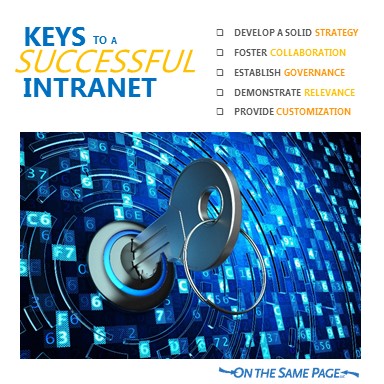 There’s a lot of confusion between the terms digital workplace, intranets, portals and hubs. To me, they all describe the same thing – a collection of digital tools, and/or a common digital space, that helps employees stay focused and on top of relevant information, provides access to the work tools that keep them efficient and which also connects them to the colleagues they need to interact with, no matter if they are around the corner or around the world.
There’s a lot of confusion between the terms digital workplace, intranets, portals and hubs. To me, they all describe the same thing – a collection of digital tools, and/or a common digital space, that helps employees stay focused and on top of relevant information, provides access to the work tools that keep them efficient and which also connects them to the colleagues they need to interact with, no matter if they are around the corner or around the world.
Here are the five keys for a successful hub or portal:
- Strategy: The most successful hubs have a strategy – a reason for being – that matches business objectives. Without a clear, workable strategy your hub will quickly dissolve into chaos. It needs that business reason for being which will keep the site on point.
- Collaboration: This is where a true digital workplace comes into play. Your hub needs useful tools and designated space for online collaboration. This space is where teams will do their work and where innovation and knowledge transfer will take place. What kind of tools? Which types of space? Your strategy – and your audiences – will tell you that. But you have to ask, and listen.
- Governance: We’re often asked who should “own” the intranet? The answer is: Everyone and No One. Intranets work best when they have clear and simple policies. Good governance means active representation from all functional groups, most especially Communications, Human Resources and IT. And yet Everyone must have a stake in contributing and maintaining the content, or No One’s needs will be filled. Effective hubs are not a service provided to your employees, they’re a healthy collaboration and mix of relevant content and open space to create.
- Relevance: Content is still king. If you can’t provide relevant, compelling content that meets your users’ needs, your hub is already dead. Spend time thinking through what content and tools employees need to be effective, and continue to be interested, and then organize the hub so they can find them. And assemble cross-functional teams to keep it going.
- Customization: Or What’s in It for Me (WIFM). The ability to customize a portion of a common corporate homepage leads to better and more frequent usage of a hub. Set aside room for a user’s local and/or business unit news, and allow users to choose links for the homepage to the tools and resources they use most often. It’s their hub too; let them mold it to their own hands.
These are just the top notes. How you use your portal, your hub, or what you design a mobile app to do, depends on the make-up, the business needs and usage of your audience. That can be a daunting task. You don’t have to go it alone. Consider partnering with us here at OTSP. We have the experience, we have the skilled technical partners, we can help you benchmark with others, and we will be beside you as you navigate through the process, from strategy to development to launch. You can reach me via email at: Kim@on-the-same-page.com.





